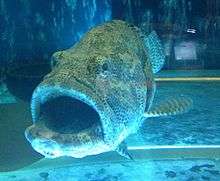Cephalopholis leopardus
| Leopard grouper | |
|---|---|
 | |
| A Leopard Grouper for sale as live seafood in a Hong Kong restaurant. | |
| Scientific classification | |
| Kingdom: | Animalia |
| Phylum: | Chordata |
| Class: | Actinopterygii |
| Order: | Perciformes |
| Family: | Serranidae |
| Subfamily: | Epinephelinae |
| Genus: | Cephalopholis |
| Species: | C. leopardus |
| Binomial name | |
| Cephalopholis leopardus (Lacepède, 1801) | |
Cephalopholis leopardus, also known as the Leopard grouper or Leopard hind , is a demersal Marine fish belonging to the family Serranidae.
Description
The Leopard grouper is a small medium-sized fish which grows up to 24 cm.[2] The body is fusiform or spindle-shaped and compressed laterally. The caudal fin is rounded. The mouth is big and has a superior position. The body background coloration is light brown, reddish or light green-gray. On the top part of the body, blotches form marbling like pattern. The low part is spotted. The front snout is covered with small red or dark dots . The leopard grouper can easily be confused with Cephalopholis urodeta but it differs mainly from this latter by two dark blotches located on the top part of its caudal peduncle. The caudal fin is distinguished by two red to dark lines forming a "V" and another black line parallel to the top line of the "V".[3]
Distribution & habitat
It is widely distributed throughout the tropical waters of the Indian Ocean, Red Sea, Persian Gulf and South Africa excluded, to the central island of the Pacific Ocean.[4]
Like many of the groupers, Cephalopholis leopardus lives in rich clear waters close to coral or rocky reefs from the surface until 40 metres (130 ft) depth with an average depth range from 3 to 20 metres (66 ft).[5]
Feeding
Cephalopholis leopardus is carnivorous and its diet consists mainly in small fishes and crustaceans, it's an ambush predator.
Behavior
The leopard grouper is solitary, territorial, demersal and has an nocturnal and/or a diurnal activity which can be maximal at sunrise and/or at sunset.[6] It is protogynous hermaphrodite, which means the female can evolved to male during its life.
References
- ↑ Cabanban, A.S.; Heemstra, P.C.; Samoilys, M. & Kulbicki, M. (2008). "Cephalopholis leopardus". The IUCN Red List of Threatened Species. IUCN. 2008: e.T132737A3436860. doi:10.2305/IUCN.UK.2008.RLTS.T132737A3436860.en. Retrieved 6 January 2018.
- ↑ http://eol.org/pages/204625/details#size
- ↑ Lieske & Myers,Coral reef fishes,Princeton University Press, 2009, ISBN 9780691089959
- ↑ http://www.fishbase.org/summary/6448
- ↑ http://eol.org/pages/204625/details#habitat
- ↑ Brulé & Déniel, ‘’ Expose synoptique des données biologiques sur le mérou rouge Epinephelus morio (valenciennes, 1828) du Golfe du Mexique’’, F.A.O., 1994, ISBN 9252034633
External links
- Bailly, N. (2013). Cephalopholis leopardus (Lacepède, 1801). In: Froese, R. and D. Pauly. Editors. (2013) FishBase. Accessed through: World Register of Marine Species at http://www.marinespecies.org/aphia.php?p=taxdetails&id=218185 on 2013-06-18.
- http://www.fishbase.org/summary/6448
- http://eol.org/pages/204625/details
